“The Death of the Mighty Thor,” Cable, Lucy Dreaming & More in Required Reading: Comics for 3/21/2018
Main Art by Russell Dauterman & Matt Wilson Comics Lists Required Reading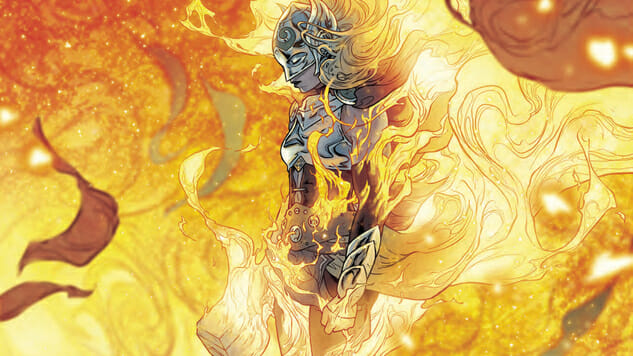
We’ve been pretty big fans of Jason Aaron’s run on Thor around these parts, whether the original lug-head Odinson with artists like Esad Ribic and Olivier Coipel, or the dignified grace of Jane Foster, as brilliantly brought to life by Russell Dauterman and Matt Wilson. So it’s with tissues in hand that we recommend The Mighty Thor #705, climax of “The Death of the Mighty Thor.” Luckily, this week carries comics with fewer devastating emotions, too. Cable finally gets a worthy creative team, 2017 frights and delights like Aliens: Dead Orbit and Moonstruck head to trade paperback format, French sci-fi anthology Infinity 8 finds an American home at Lion Forge and Max Bemis and Michael Dialynas’ Lucy Dreaming sleep-walks into our lives. All of this plus Weapon H, the comic we still can’t believe exist. It’s the Hulk with Wolverine claws, y’all!
 Aliens: Dead Orbit TPB
Aliens: Dead Orbit TPB
Writer/Artist: James Stokoe
Publisher: Dark Horse Comics
In the Dark Horse mini-series Aliens: Dead Orbit, which we hailed as one of the best comics of 2017 and one of the most essential horror comics ever, Canadian cartoonist James Stokoe applies his singular style to the world of Ridley Scott’s sprawling sci-fi franchise, melding the obsessive detail honed on books like Orc Stain with the Freudian nightmare imagery of legendary Xenomorph designer H.R. Giger. You could say we’re…Stokoe’d…for this trade collecting the entire series. Chestbursting groaner of a dad-joke aside, Stokoe has created something special with this standalone entry into the Alien canon. By harkening back to the claustrophobic, gothic horror of the first film, rather than the action-packed James Cameron sequel, Aliens, or any of the Xenomorph-stuffed expanded-universe installments, Stokoe evokes the terrifying roots of the founding work of sci-fi terror. In Dead Orbit, a lone engineer fights for his life against a seemingly unstoppable phallo-vaginal monstrosity from outer space—a horrific isolation best experienced in one straight shot. Steve Foxe
 Cable #155
Cable #155
Writers: Lonnie Nadler & Zac Thompson
Artist: German Peralta
Publisher: Marvel Comics
Cable has struggled throughout his latest iteration, first with a James Robinson/Carlos Pacheco arc that was serviceable but lost amid flashier mutant titles, and then with an Ed Brisson/Jon Malin storyline that attracted attention for all the wrong reasons as Malin crusaded against “social justice warriors” on Twitter. If Cable #155 is any indication, Marvel needs to lock down creators Lonnie Nadler, Zac Thompson and German Peralta for the foreseeable semi-apocalyptic future, as the trio (along with colorist Jesus Aburtov and killer cover artist Daniel Warren Johnson) deliver the most promising Cable kickoff in years with their first issue. Cable, with his light-up eye, techno-organic arm and physics-defying guns, is an easy character to make cool, but a difficult one to make interesting, and Nadler and Thompson accomplish both by leaning into his long and complex history, especially his surprisingly touching relationship with his adopted daughter Hope. Hope played a massive role in the X-Men comics a decade ago before receding into the background of mutant redheads destined for greatness, and Nadler and Thompson are smart to reestablish this important part of Cable’s humanity. Of course, Nadler and Thompson are best known for repulsivebody horror, and Cable’s relationship to the Akira-evoking techno-organic virus provides the other perfect anchor for their approach to the time-sliding silver daddy of the X-Men, with Peralta and Aburtov rising to the skin-ripping occasion with ease. Between this and last week’s New Mutants: Dead Souls, “X-Men with a touch of horror” is proving to be a shockingly effective formula. Steve Foxe
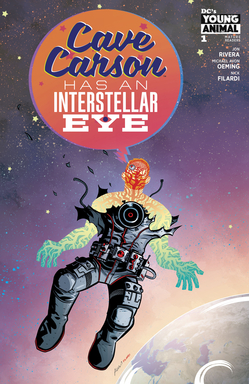 Cave Carson has an Interstellar Eye #1
Cave Carson has an Interstellar Eye #1
Writer: Jon Rivera
Artist: Michael Avon Oeming
Publisher: Young Animal/ DC Comics
Shade, the Changing Woman isn’t the only Young Animal book getting a slightly different title in the wake of the “Milk Wars” event that brought Gerard Way’s wonderfully weird books into the same continuity as Justice League of America and DC’s tent-pole characters. Though it hasn’t received as much attention at times as the other YA titles, Cave Carson has a Cybernetic Eye proved to be just as strange and complex and necessary, a much-needed shot in the arm for DC that didn’t focus purely on cape-and-cowl heroes. With the Milk Wars behind them, the titular Carson and his daughter Chloe embark on a new adventure under writer Jon Rivera and artist Michael Avon Oeming, who’ve been on Cave since the beginning. The first story arc was like Disney’s Atlantis meets Stargate, and this new adventure takes them from below the Earth’s crust to way up in outer space. With the new title and a brand-new angle, this is the perfect point for curious readers to jump on (and then hopefully go back and read the first 12 issues, too.) Caitlin Rosberg
 Ice Cream Man #3
Ice Cream Man #3
Writer: W. Maxwell Prince
Artist: Martin Morazzo
Publisher: Image Comics
Ice Cream Man billed itself as a Twilight Zone-inspired horror anthology out of the gate, and its first two issues, flush with lycanthropic frozen-goods peddlers, killer spiders and the ravages of drug abuse, reinforced that horror. This third issue tunes into a different frequency, relying more on melancholy than outright fear. The story’s protagonist is a washed-up one-hit-wonder who now spends his days at the local diner, reminding the waiter of his past glory and wondering if he only ever had that one song in him…until an extra-dimensional crew of musical heroes (styled after some very recognizable faces) shows up to recruit the sad sack into an epic war for all of creation. Writer W. Maxwell Prince pivots to Invisibles-esque mind-expanding action with ease, and artist Martin Morazzo displays a range in these three issues that demonstrates that he’s on the cusp of becoming a go-to name for the weird and wonderful. Steve Foxe
 Infinity 8 #1
Infinity 8 #1
Writers: Lewis Trondheim & Zep
Artist: Dominique Bertail
Publisher: Lion Forge
With the advent of the Internet and rising interest in comics without superheroes in them, it’s becoming increasingly easy to find comics from other countries in the U.S. (especially digitally), but it’s still uncommon for a traditional American publisher to distribute content from outside the country. Lion Forge is bucking a lot of trends these days, pushing into the Young Adult comic market and establishing its own diverse superhero universe, and this is yet another: they’re bringing French publisher Rue de Sèvre’s Infinity 8 to American readers. The series brings together some of the most popular comic creators in France and unleashes them on pulpy science fiction. Each team has three issues to tell a self-contained story, but the overall series is interconnected by a central mystery. It’s like an anthology on steroids, eight individual central characters investigating crimes on a spaceship the size of a city, their stories told in parallel. This first arc is written by Lewis Trondheim and Zep, with art by Dominique Bertail, and American readers would do well not to sleep on this opportunity to brush up on the flourishing French scene. Caitlin Rosberg
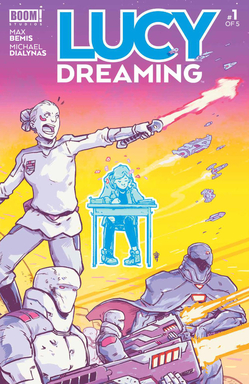 Lucy Dreaming #1
Lucy Dreaming #1
Writer: Max Bemis
Artist: Michael Dialynas
Publisher: BOOM! Studios
Max Bemis carries an ever-lit candle for underdogs finding their identities. That mission has held true throughout his career as frontman for pop-punk institution Say Anything, and more recently as an inventive comic scribe with a growing library. Bemis poked endearing fun at aging escapists in Oh, Killstrike, which saw a timid new father come to terms with his responsibilities through the excessive filter of ‘90s extreme comics. Worst X-Man Ever continued that focus on self-realization, starring an un-merry mutant with an admittedly awful power—he can blow himself up…once—learning to embrace his internal homo superior. Bemis is currently applying his subtle characterization to Moon Knight with artist Jacen Burrows, but he introduces another nocturnal adventurer this week with Lucy Dreaming. A five-issue miniseries courtesy BOOM! Studios with The Woods artist Michael Dialynas, the comic is a “sweeping, bildungsroman about living your dreams—literally.” The titular character is a grade-school dreamer of every definition, transcending her mundane surroundings every night for a series of grand excursions. The premise sounds rich, allowing the creators to address any genre with ample room for humor—the cover hints at Star Wars-by-Moebius sci-fi, and watching Bemis and Dialynas tackle the unrestrained imagination of an adolescent should be a joy. Dialynas is also handling coloring duties, layering in otherworldly gradients and vivid hues to mark the contrast between dreary reality and slumbering excitement. Sean Edgar & Steve Foxe
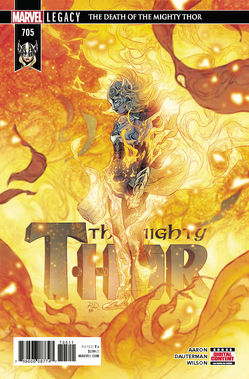 The Mighty Thor #705
The Mighty Thor #705
Writer: Jason Aaron
Artist: Russell Dauterman
Publisher: Marvel Comics
In the fall of 2014, readers met an all-new, all-different version of Thor. The long blond hair, red cape, winged helmet and mighty hammer were still there, but under all of the trappings of the God of Thunder was a woman. Odinson had lost the right to wield Mjolnir, and over the first few issues of the series, readers discovered that the new Thor was none other than former Thor love interest and supporting character Jane Foster, riddled with cancer but still trying to do her part to protect others. “Lady Thor” as she was both affectionately and derisively known, was in many ways the standard bearer for a new age at Marvel: Thor was a woman, and soon enough Captain America was a black man and even later than that Iron Man was a young black woman, Hulk was a Korean-American teen and so on. There were over a dozen shake-ups across the Marvel books, with the biggest names in the MCU looking very different than before. Mighty Thor #705 marks the end of the era of Lady Thor, and in many ways the end of an even larger era at Marvel. Most of the changes that have debuted in the last few years have already been reversed, and those that haven’t seem likely to disappear during the “Fresh Start” reboot in May. This run of Mighty Thor has been fascinating not only for the responses it garnered from readers, but because it put both Odinson and Jane Foster in uncommon positions, both vulnerable and flawed, each striving for something beyond themselves. In Odinson’s case, he lost the identity he constructed for himself; in Jane’s, she was confronting her own mortality while simultaneously wielding more power than ever before. Jane was allowed to be both a strong, invincible superhero and a fragile, ill woman, with a dignity and grace that is hard to come by in any media, let alone a mainstream superhero comic book. Jason Aaron, Russell Dauterman and Matt Wilson have spent the last three and a half years making something truly remarkable together, and this issue, the climax of “The Death of the Mighty Thor,” is an important one to note. Caitlin Rosberg
 Moonstruck Vol. 1
Moonstruck Vol. 1
Writer: Grace Ellis
Artists: Shae Beagle, Kate Leth
Publisher: Image Comics
Grace Ellis, one of the minds behind Lumberjanes, returned to comics with Moonstruck, which brings the best parts of fan-fiction to Image Comics. Moonstruck is the coffee-shop AU a lot of readers will find familiar: a queer-friendly supernatural story starring a werewolf barista who’s just trying to have a normal life, surrounded by humans and other magical creatures alike. Ellis has a skill for writing fun, frothy stories with a lot of heart, and she teamed up with Shae Beagle, a relative newcomer to print comics with a sizable online following. Beagle’s style is cutesy and rounded, but very expressive, which suits a book like Moonstruck. Since the start of Lumberjanes, Ellis has worked with teams of skilled women for both the main title and backup stories, and there’s no reason to think Moonstruck would be any different, as cartoonist Kate Leth contributes shorts throughout the volume. Fans of Moonstruck should also check out the Eisner-nominated Deja Brew by Taneka Stotts and Sara DuVall, further proof that the liminal spaces of cafes and bistros are perfectly suited to comics with a lot of heart and beautiful art. Caitlin Rosberg
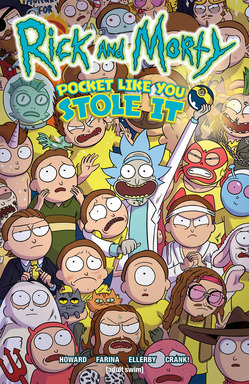 Rick and Morty: Pocket Like You Stole It TPB
Rick and Morty: Pocket Like You Stole It TPB
Writer: Tini Howard
Artist: Marc Ellerby
Publisher: Oni Press
Adult Swim sensation Rick and Morty has a seemingly endless ability to parody popular culture from fresh angles, including the gotta-catch-’em-all phenomenon of Pokémon and its app explosion, Pokémon GO, filtered through the show’s off-kilter humor as Pocket Mortys, a real app that proved just as addictive as its source inspiration. Rick and Morty: Pocket Like You Stole It taps Rick and Morty series art contributor Marc Ellerby and Black Crown rising star (and former Paste contributor) Tini Howard to skewer the implications of catching Mortys and forcing them into battle for fun and profit. Poking fun at Pokémon’s core premise of digital dog fights isn’t anything new—PETA infamously, humorlessly does it every time a new installment of the franchise hits shelves—but Rick and Morty is at the top of its game when it comes to lampooning pop culture (even with future seasons newly in doubt), and Howard, Ellerby and colorist Katy Farina display the chops to become Pokémon champions—err, Morty masters, something like that—in this collected volume. Steve Foxe
 Weapon H #1
Weapon H #1
Writer: Greg Pak
Artist: Cory Smith
Publisher: Marvel Comics
It’s hard to imagine a mainstream comic with more incredulity thrown at it before its first issue than Weapon H, which spins out of Greg Pak’s tenure on Weapon X, as well as the crossover Weapons of Mutant Destruction with Totally Awesome Hulk. Pak and the X-Men editorial office committed over a dozen issues, including the first two full arcs of Weapon X, to introducing and establishing the titular Weapon H, a former soldier experimented on by the shadowy organization Weapon X in an attempt to produce the perfect weapon. This time, the formula combines Wolverine’s claws, healing factor and adamantium bones with the Hulk’s rage-out transformations and gamma-irradiated strength. (Weapon H may also incorporate powers from Domino and Deathstrike and the rest of Old Man Logan’s wetworks team, but those are pretty redundant when you’ve already got the friggin’ Hulk with Wolverine claws). As Marvel tries to re-simplify its line and put its most iconic characters back to the forefront, Weapon H feels like the last gasp of an editorial directive to wring the absolute most out of every possible popular property, and even Pak’s solid track record makes this one more of a perverse curiosity than a full-throated recommendation, especially when paired with the fairly straightforward art of Cory Smith. If this one manages to surprise, consider it a miracle. If Marvel is doing its best to pretend Weapon H never happened in a year’s time, forget we even mentioned it. Steve Foxe